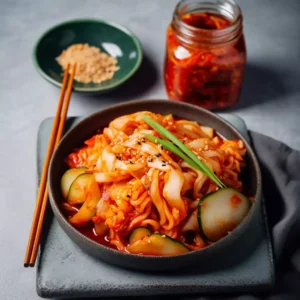
Kimchi, a staple in Korean cuisine, is a flavorful and spicy fermented vegetable dish that has been enjoyed for centuries. The best kimchi recipe that you can find.
Originating from Korea, kimchi has gained popularity worldwide for its unique taste and health benefits.
While it may seem daunting to make at first, creating homemade kimchi is a rewarding culinary experience that allows you to customize the flavors to your liking.
Expert Tip: Use disposable gloves when massaging the kimchi paste into the cabbage to avoid staining your hands and to evenly distribute the flavors.
Napa Cabbage: Provides the crunchy base for kimchi and absorbs the flavors of the seasoning.
Salt: Essential for brining the cabbage, which helps to draw out excess moisture and create the perfect texture.
Ginger: Adds a warm and aromatic flavor to the kimchi paste, enhancing its complexity.
Garlic: Contributes its distinct pungent taste and depth of flavor to the kimchi.
Fish Sauce: Offers a savory umami element to the kimchi, balancing the flavors and adding depth.
Soy Sauce: Provides a salty and savory taste to the kimchi paste, complementing the other ingredients.
Korean Red Pepper Flakes (Gochugaru): Infuses the kimchi with its signature spicy kick and vibrant red color.
Sugar: Helps to balance the flavors and enhances the fermentation process.
Green Onions: Add freshness and a mild onion flavor to the kimchi.
Carrot: Contributes sweetness and texture to the kimchi, as well as visual appeal.
Expert Tip: Ensure the cabbage is thoroughly rinsed after brining to remove excess salt, as this will prevent the kimchi from being overly salty.
Expert Tip: Leave some headspace in the jars when packing the kimchi to allow for expansion during fermentation and to prevent overflow.
Napa cabbage is traditionally used for making kimchi due to its unique texture and flavor, but you can experiment with other types of cabbage if necessary. However, keep in mind that the taste and texture may vary slightly from traditional kimchi.
Homemade kimchi can typically last for several weeks to months when stored properly in the refrigerator. The flavor will continue to develop over time as it ferments, so it’s best to taste it periodically and consume it within a few weeks for optimal flavor.
Yes, you can adjust the spiciness of your kimchi by adding more or less Korean red pepper flakes (Gochugaru) according to your preference. Start with a smaller amount and gradually increase until you reach your desired level of heat.
If your kimchi turns out too salty, it may be due to not rinsing the cabbage thoroughly after brining or using too much salt in the recipe. Make sure to rinse the cabbage well under cold water to remove excess salt before proceeding with the recipe.
While kimchi can be consumed immediately after making it, it’s best to allow it to ferment for at least 6 hours to 2 days at room temperature to develop its full flavor. However, if you prefer a milder taste, you can enjoy it right away.
Here are some more recipes for you to enjoy! If you my recipes don’t forget to rate and leave a comment.
If you have any recipe suggestions, please do not hesitate to ask me. A great way to stay in contact with me is through Instagram, Facebook, Twitter and YouTube. Don’t forget to tag me @CookwithNabeela in your recipe photos!

Subscribe now to receive my latest recipes directly in your inbox. Stay up-to-date and never miss out!

I love to cook! I want to share with you my favourite, delicious family-friendly recipes. I want to inspire you to create fantastic food for your family every day.
Add your first comment to this post